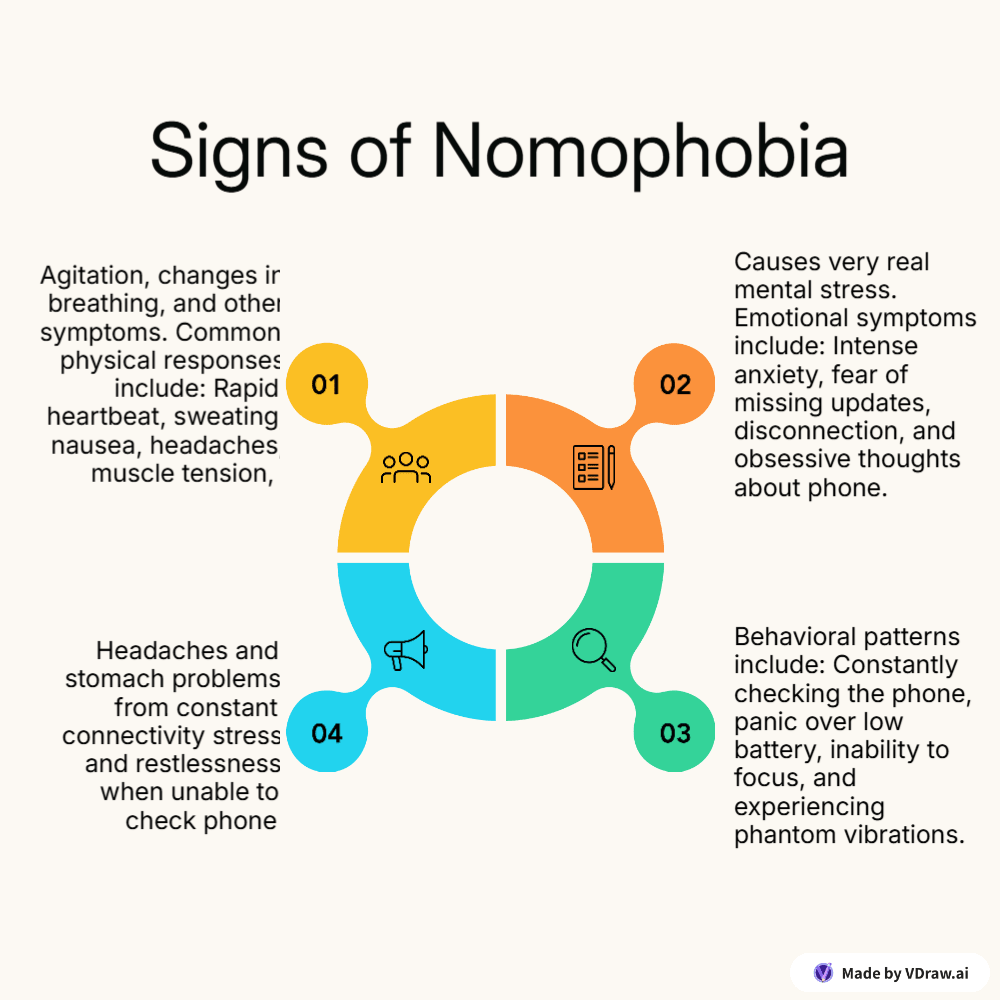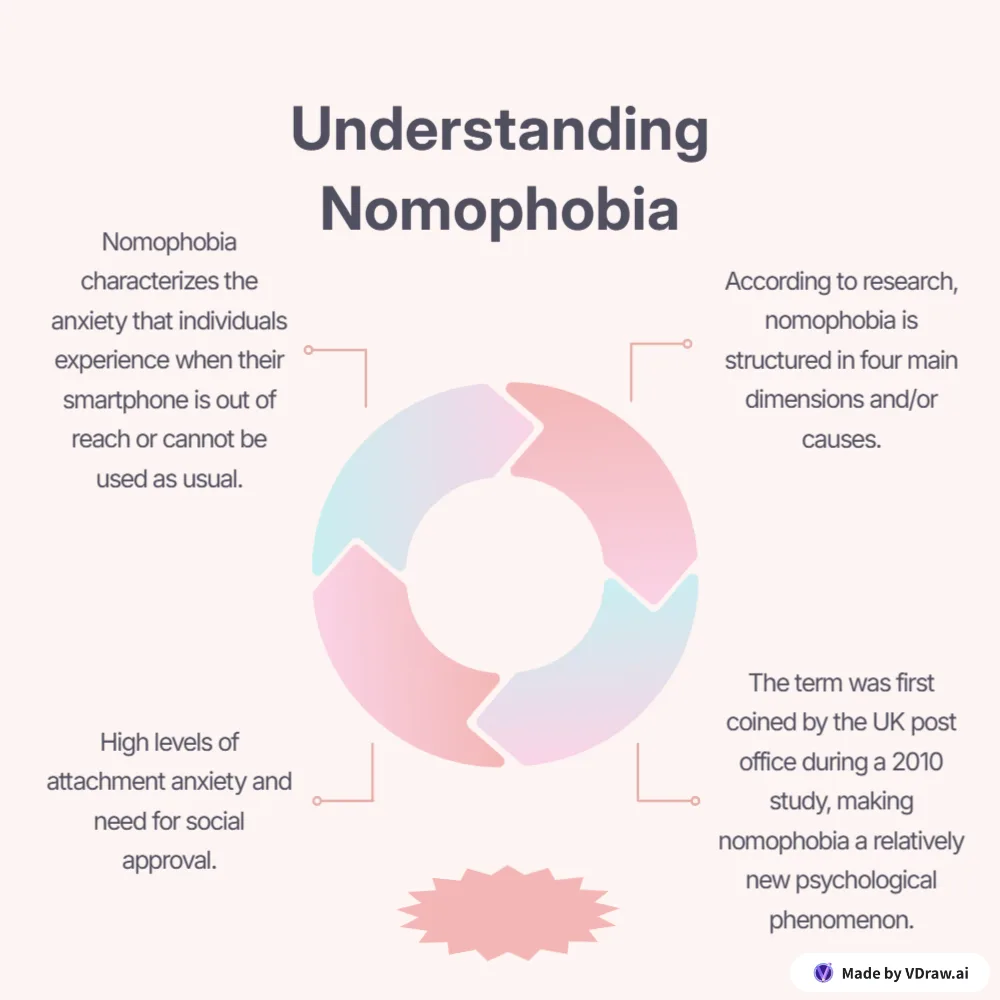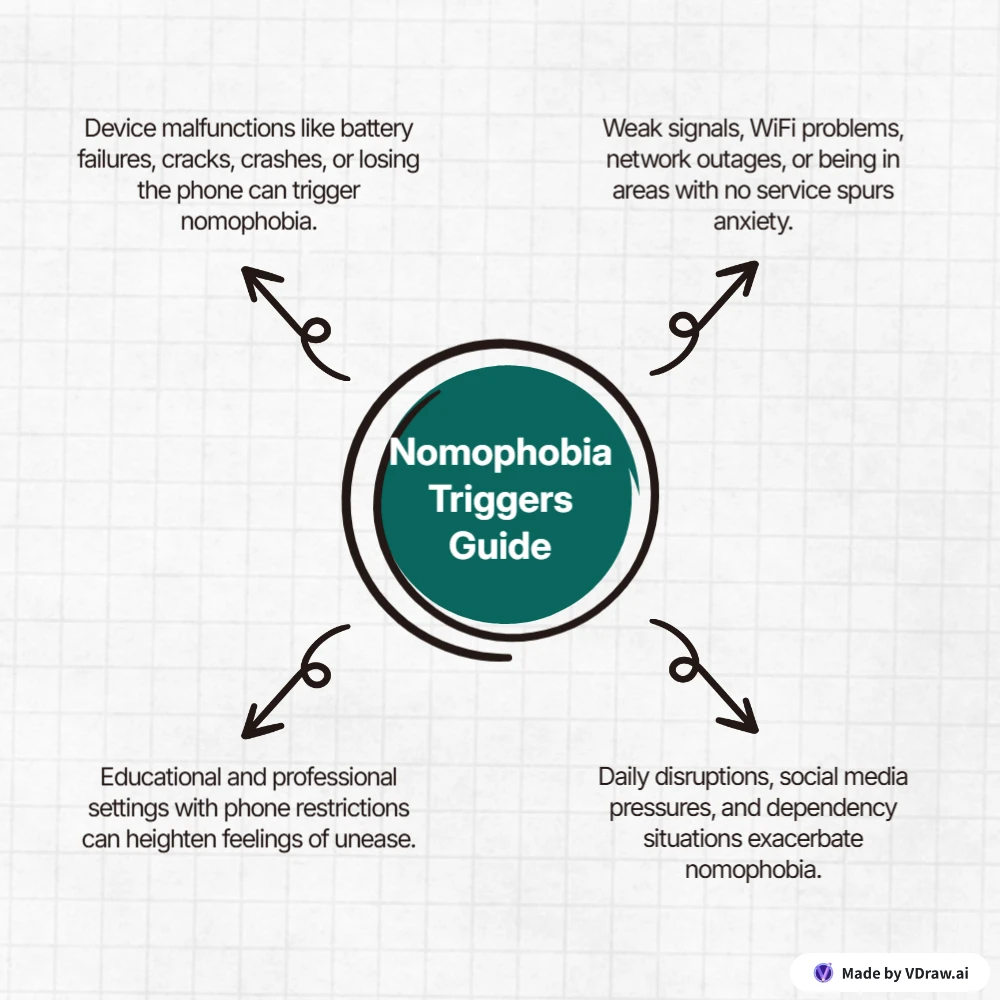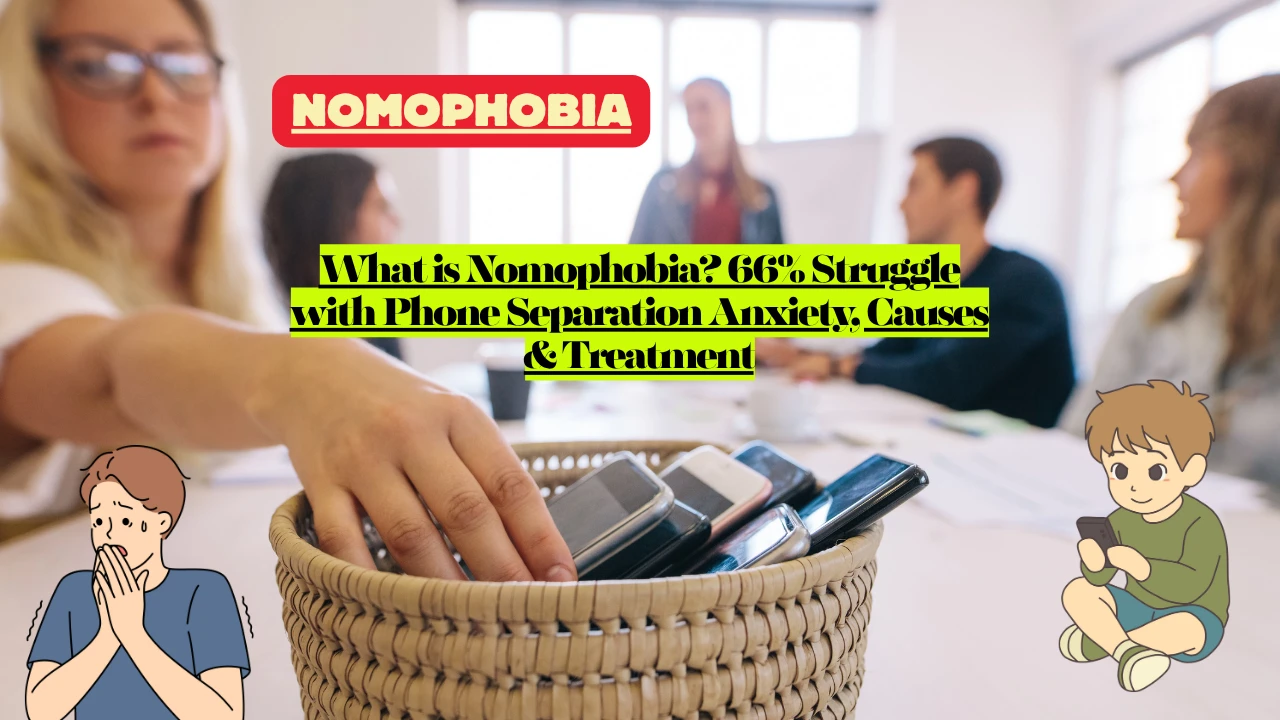What Exactly Is Nomophobia?
Nomophobia is anxiety or panic when separated from your mobile phone or unable to use it. Unlike simple attachment, nomophobia involves measurable distress that interferes with daily functioning—work, relationships, sleep, and mental health.
The Four Core Fears
Research identifies four main dimensions:
- Communication Anxiety: Fear of missing calls, texts, or messages
- Connection Loss: Panic about losing contact with family, friends, social networks
- Information Access: Anxiety about not being able to search, check facts, or access data instantly
- Convenience Loss: Distress about losing phone’s functional benefits (GPS, payments, photos)
Is It Psychological or Physiological?
Both. Nomophobia is a psychophysiological condition involving:
Here’s what you need to know right away:
- It affects approximately 66% of people to some degree
- Research shows 26% have mild symptoms, 51% moderate symptoms, and 21% severe symptoms
- The prevalence of severe nomophobia is 20.81% globally
- It’s considered a modern anxiety disorder that can significantly impact daily functioning
- Effective treatments exist, including cognitive behavioral therapy and digital wellness strategies
At AllThePhobias.com, we’ve compiled the most current research from 2024 and professional insights to help you understand and address nomophobia. The term NOMOPHOBIA is constructed on definitions described in the DSM-IV, it has been labelled as a “phobia for a particular era” representing one of the most common modern psychological concerns.
Do You Have Nomophobia? Key Signs to Look For
Physical Symptoms When Away From Your Phone
Nomophobia can lead to agitation, changes in breathing, and other symptoms. Common physical responses include:
- Rapid heartbeat and palpitations when phone is unreachable
- Sweating and trembling when battery dies or signal is lost
- Nausea and stomach upset during phone separation
- Headaches and stomach problems from constant connectivity stress
- Muscle tension and restlessness when unable to check phone
- Sleep disturbances from fear of missing notifications
Emotional & Mental Responses
Nomophobia causes very real mental stress, most often to children, teens and young adults. Emotional symptoms include:
- Intense anxiety and panic when phone is not accessible
- Fear of missing important calls, texts, or social media updates
- Feeling disconnected from the world without phone access
- Depression or isolation when unable to maintain digital connections
- Irritability and mood swings during phone separation
- Obsessive thoughts about checking phone or missing notifications

Behavioral Changes
Nomophobia occurs in situations when an individual experiences anxiety due to the fear of not having access to a mobile phone. Behavioral patterns include:
- Constantly checking phone even when no notifications are present
- Panic when phone battery is low or dying
- Inability to focus on tasks without phone nearby
- Avoiding places with poor cell service or no WiFi
- Carrying multiple chargers and backup batteries everywhere
- Checking phone immediately upon waking and before sleeping
- Experiencing “phantom vibrations” – feeling phone buzz when it hasn’t
When Concern Becomes Clinical Significance: Nomophobia can have a significant impact on mental health, leading to increased anxiety, impaired sleep, and reduced productivity when it interferes with work, relationships, or daily functioning for extended periods.
Related Phobia: What is Submechanophobia? Why 12.5% of U.S. Adults Fear Submerged Objects (Causes, Symptoms & Cure)

Understanding Nomophobia: What Causes This Fear?
The Science Behind Digital Dependency
Neurological Mechanisms: Nomophobia characterizes the anxiety that individuals experience when their smartphone is out of reach or cannot be used as usual. The fear response is triggered by:
- Dopamine release cycles created by phone notifications and social media interactions
- FOMO (Fear of Missing Out) activated by constant connectivity expectations
- Attachment theory principles where phones become “secure base” objects
- Classical conditioning linking phone availability with safety and social connection
The Four Main Dimensions of Nomophobia: According to research, nomophobia is structured in four main dimensions and/or causes:
- Not being able to communicate with others through calls or messages
- Losing connectedness to family, friends, and social networks
- Not being able to access information instantly when needed
- Giving up convenience of mobile phone functionality
Development Patterns
Modern Digital Evolution: The term was first coined by the UK post office during a 2010 study, making nomophobia a relatively new psychological phenomenon directly tied to smartphone proliferation.
Age and Demographic Patterns:
- This stuff tends to hit harder for teens and young adults, who usually rely on their phones more for things like texting, social media, and staying connected with people
- Females and young people seem to be more vulnerable to nomophobia
- Digital natives (born into smartphone era) show higher susceptibility
- College students and young professionals demonstrate highest prevalence rates
Triggers for Development:
- Increased social media usage and online relationship dependency
- Work or school requirements for constant digital availability
- Social pressure to respond immediately to messages
- Past experiences of missing important calls or messages
- General anxiety disorders that manifest through digital connectivity fears
Risk Factors
Personality and Psychological Factors:
- High levels of attachment anxiety and need for social approval
- Low self-esteem and fear of social rejection
- Perfectionist tendencies and need for control
- Existing anxiety disorders or depression
- Addictive personality traits
Social and Environmental Factors:
- Any level of nomophobia was 30% higher among participants whose father had higher education
- Peer groups with high smartphone dependency
- Work environments requiring constant connectivity
- Social isolation or limited face-to-face relationships
- Cultural emphasis on immediate responsiveness
Technological Factors:
- Smartphone features designed to create engagement and dependency
- Social media algorithms promoting constant checking behaviors
- Push notifications and attention-grabbing app designs
- Easy access to entertainment, information, and social validation through devices
How It Differs From Normal Phone Attachment
Clinical Diagnostic Considerations: While not yet included in the DSM-5 as a specific disorder, nomophobia shares characteristics with:
- Specific phobias (fear of particular situations)
- Separation anxiety disorder
- Internet addiction disorder
- Social anxiety disorder
Severity Indicators:
- Normal attachment: Mild inconvenience when phone is unavailable
- Problematic use: Significant distress affecting daily activities
- Clinical nomophobia: Severe impairment in social, occupational, or other functioning areas
Duration and Intensity: Normal phone attachment involves temporary mild discomfort, while nomophobia involves persistent, intense anxiety that may last hours or days after phone separation.

Comprehensive Triggers & Situations: Complete Guide to Nomophobia Triggers
Technology-Related Triggers
Device Malfunction Scenarios:
- Battery dying or completely dead phone
- Cracked screen or physical damage preventing use
- Software crashes or frozen applications
- Lost or stolen phone situations
- Water damage or hardware failures
- Forgetting phone at home or in another location
- Dropping phone and fearing it’s broken
Connectivity Issues:
- No cell service or weak signal areas
- WiFi connection problems or slow internet
- Network outages or provider service interruptions
- International travel with different network requirements
- Underground locations (subways, basements, parking garages)
- Rural or remote areas with limited coverage
- Airplane mode requirements during flights
Environmental and Situational Triggers
Educational Settings:
- Exam periods requiring phones to be turned off or stored
- Classroom policies prohibiting phone use
- Library quiet zones with phone restrictions
- School events with phone collection policies
- Digital detox assignments or challenges
- Study abroad programs with limited international service
Professional Environments:
- Meetings requiring phones to be silenced or put away
- Secure facilities where phones must be left outside
- Jobs with strict no-phone policies during work hours
- Client presentations where phone use is unprofessional
- Medical procedures requiring phone storage
- Court appearances or legal proceedings with phone restrictions
Social Situations:
- Dinner parties or family gatherings with “phone-free” rules
- Religious services or ceremonies requiring silence
- Theater performances, concerts, or movies
- Meditation retreats or mindfulness workshops
- Camping trips or outdoor adventures in remote areas
- Sports events or activities where phones could be damaged
Modern Lifestyle Triggers
Daily Routine Disruptions:
- Morning routines without immediate phone access
- Commuting without phone (forgotten, dead battery, or lost)
- Work presentations where phone must be stored
- Exercise or gym sessions where phone might be stolen
- Medical appointments where phones must be turned off
- Sleep situations where phone is charging in another room
Social Media and Communication Pressures:
- Fear of missing important group chat conversations
- Anxiety about not responding to messages immediately
- Worry about missing live social media content or stories
- FOMO about real-time events happening online
- Concern about appearing “offline” or unavailable to others
- Fear of missing work-related communications outside office hours
Digital Dependency Situations:
- Navigation needs when driving without GPS access
- Payment situations when relying on digital wallet apps
- Travel requiring digital boarding passes or reservation confirmations
- Emergency situations where phone is needed for safety
- Photography moments when phone camera is primary device
- Information needs where phone is primary search tool
Real-World Impact & Life Challenges
Brief Example: Marcus, a 24-year-old marketing coordinator, discovered his nomophobia was affecting his career when he had panic attacks during phone-free client meetings. He would make excuses to leave meetings early and check his phone, sometimes missing crucial project discussions. After recognizing the problem and working with a therapist specializing in digital anxiety, he learned coping strategies that allowed him to participate fully in work activities while managing his phone dependency in healthy ways.
Common Life Areas Affected
Work and Career Implications:
- Reduced productivity when constantly checking phone or worrying about missed communications
- Difficulty concentrating on tasks requiring sustained attention
- Unprofessional behavior during meetings or client interactions
- Increased stress about after-hours work communication expectations
- Career limitations in roles requiring phone restrictions or security clearances
- Reduced face-to-face communication skills affecting professional relationships
Relationships and Social Situations:
- Romantic Relationships: Partner conflicts about phone use during quality time
- Family Dynamics: Missing important family moments due to phone preoccupation
- Friendships: Difficulty maintaining in-person conversations without phone checking
- Social Events: Anxiety at phone-free gatherings or entertainment venues
- Parenting: Modeling unhealthy phone dependency behaviors for children
- Social Skills: Decreased ability to engage in unstructured social interactions
Personal Activities and Well-being:
- Sleep Quality: Impaired sleep from fear of missing notifications
- Physical Health: Reduced exercise and outdoor activities due to connectivity concerns
- Mental Health: Increased anxiety and stress levels affecting overall emotional well-being
- Hobbies: Limitation of activities that don’t allow phone access or use
- Travel: Avoiding destinations with poor connectivity or high roaming costs
- Personal Growth: Difficulty engaging in mindfulness, meditation, or self-reflection practices
Educational and Learning Impact:
- Decreased academic performance due to constant phone checking during study
- Difficulty engaging in classroom discussions or lectures
- Reduced ability to focus on reading or research without digital distractions
- Anxiety during exams or tests where phones are prohibited
- Challenges with traditional learning methods that don’t incorporate technology
Treatment & Recovery Options: Proven Ways to Overcome Nomophobia
Professional Treatment (Most Effective)
Cognitive Behavioral Therapy (CBT): CBT shows significant effectiveness for technology-related anxiety disorders, with success rates typically ranging from 70-85% for anxiety-related conditions when patients complete treatment programs.
How CBT Works for Nomophobia:
- Identifying and challenging catastrophic thoughts about phone separation
- Learning to recognize physical anxiety symptoms and their triggers
- Developing healthy coping strategies for phone-free situations
- Gradual exposure therapy starting with brief phone separations
- Cognitive restructuring to address FOMO and communication anxiety
- Typical treatment duration ranges from 12-16 sessions over 3-4 months
Digital Wellness Therapy: A specialized approach combining traditional therapy with technology-specific interventions:
- Screen time analysis and healthy usage goal setting
- App management and notification customization strategies
- Mindful technology use training and awareness building
- Social media detox and relationship building offline
- Digital boundary setting for work-life balance
Specialized Treatment Approaches:
Acceptance and Commitment Therapy (ACT):
- Accepting anxiety about phone separation while committing to valued life activities
- Mindfulness training to observe phone urges without immediately acting
- Values clarification to understand what matters beyond digital connectivity
- Psychological flexibility training to adapt to various phone availability situations
Mindfulness-Based Stress Reduction (MBSR):
- Learning to be present without constant digital stimulation
- Body awareness practices to recognize physical anxiety symptoms
- Meditation techniques that can be used during phone separation periods
- Stress reduction skills applicable to various life situations beyond phone use
Self-Help Strategies
Gradual Exposure Techniques: Deliberately designating a specific time each day to put away phones can help reduce the distress related to this attachment
Progressive Phone Separation Practice:
- Start with 10-minute phone-free periods during low-stress times
- Gradually increase duration to 30 minutes, then 1 hour, then longer
- Practice phone separation during different activities (meals, walks, reading)
- Use airplane mode instead of complete phone removal initially
- Keep phone in another room during specific activities
Digital Wellness Strategies:
- Turn off non-essential notifications and alerts
- Establish phone-free zones in home (bedroom, dining room)
- Create specific times for checking messages and social media
- Use “Do Not Disturb” settings during focused activities
- Replace phone checking with alternative comfort behaviors
Breathing and Mindfulness Techniques:
- 4-7-8 breathing when feeling anxious about phone separation
- Progressive muscle relaxation focusing on releasing technology-related tension
- Mindfulness meditation practices that don’t require phone apps
- Grounding techniques using physical senses rather than digital input
Lifestyle Modifications:
- Develop hobbies and interests that don’t require phone use
- Strengthen face-to-face relationships and social connections
- Regular exercise and physical activities to reduce overall anxiety
- Establish consistent sleep routines without phone dependence
- Practice delayed gratification by waiting to respond to messages
When to Seek Professional Help
Immediate Professional Support Needed:
- Panic attacks lasting more than 30 minutes when separated from phone
- Complete inability to function at work or school without phone access
- Physical symptoms (heart problems, severe sleep disruption) related to phone anxiety
- Relationship breakdowns directly caused by phone dependency behaviors
- Depression or suicidal thoughts related to digital connectivity issues
Consider Professional Help If:
- Self-help strategies haven’t improved symptoms after 2-3 months
- Nomophobia symptoms are worsening despite efforts to manage them
- Phone anxiety is spreading to other areas of technology use
- Work performance or academic achievement is significantly declining
- Family or friends express serious concerns about your phone dependency
Legal Rights & Workplace Accommodations
Understanding Your Rights in Digital Workplaces
Americans with Disabilities Act (ADA) Considerations: If severe nomophobia significantly impacts work performance and qualifies as a disability under ADA guidelines, potential workplace accommodations might include:
Potential Workplace Accommodations:
- Gradual phone separation training during work hours
- Modified communication expectations for immediate responses
- Alternative communication methods for urgent work matters
- Flexible break schedules allowing brief phone check periods
- Private workspace accommodations to manage anxiety episodes
- Modified job duties that don’t require extended phone separation
Documentation Requirements:
- Mental health professional diagnosis confirming functional impairment
- Specific accommodation requests with rationale
- Medical documentation of how nomophobia affects work performance
- Evidence that accommodations won’t create undue hardship for employer
Digital Rights in Educational Settings:
- Student accommodation services may provide support for phone-related anxiety
- Extended time on exams if phone separation creates severe anxiety
- Alternative arrangements for phone-free testing environments
- Academic support for managing technology-related learning challenges
Family Impact & Parenting Considerations
When Parents Have Nomophobia
Impact on Family Life: Parents with nomophobia face unique challenges affecting entire families:
- Difficulty engaging in uninterrupted family activities or conversations
- Modeling unhealthy phone dependency behaviors for children
- Increased family conflict about phone use during meals or family time
- Safety concerns when phone preoccupation distracts from child supervision
- Challenges establishing healthy technology boundaries for children
Teaching Children About Healthy Phone Use:
- Age-appropriate discussions about technology balance and mental health
- Modeling healthy phone behaviors rather than just setting rules
- Creating family phone-free times and activities together
- Helping children understand that adults can also struggle with technology balance
- Establishing family media agreements that apply to all members
Family Genetic and Environmental Considerations: Research suggests that children of parents with technology-related anxiety may be more likely to develop similar patterns, indicating both genetic and learned components to nomophobia development.
Parenting with Nomophobia
Unique Parenting Challenges:
- Managing child safety concerns while addressing phone dependency
- Balancing legitimate parental communication needs with unhealthy phone attachment
- Teaching children healthy technology use while managing personal phone anxiety
- Handling school communications and emergency contact expectations
- Managing work-from-home expectations while providing adequate child supervision
Co-Parenting and Technology:
- Coordinating childcare and custody arrangements when phone anxiety is present
- Managing different technology rules and expectations between households
- Communication with other parent about nomophobia impact on parenting decisions
- Emergency planning when phone dependency might affect crisis response
Financial Impact & Insurance Navigation
Real Costs of Living with Nomophobia
Healthcare Expenses:
- Therapy sessions: $100-250 per session for specialized digital wellness therapy
- Psychiatric consultations: $300-500 initial assessment, $150-300 follow-ups
- Digital wellness coaching: $75-150 per session
- Intensive outpatient programs: $1,000-3,000 per month
- Medication if anxiety or depression co-occurs: $20-300+ monthly
Technology-Related Costs:
- Multiple phone chargers, battery packs, and backup devices: $200-500 annually
- Enhanced phone insurance and protection plans: $10-25 monthly
- Premium connectivity plans to reduce anxiety about service interruptions: $20-50 extra monthly
- Multiple device ownership (phone, tablet, smartwatch) to ensure connectivity: $1,000-2,000 annually
Productivity and Career Impact:
- Reduced work efficiency affecting performance evaluations and advancement
- Potential job limitations avoiding roles with phone restrictions
- Costs of missed opportunities due to phone-checking behaviors during important meetings
- Professional development limitations in fields requiring technology balance
Insurance Coverage Strategies:
- Mental health parity laws ensure equal coverage for technology-related anxiety disorders
- Many insurance plans cover CBT and specialized anxiety treatments
- Employee Assistance Programs (EAP) often provide free initial counseling sessions
- Health Savings Accounts (HSA) can cover therapy and treatment costs
- Check for coverage of digital wellness programs and specialized technology addiction treatment
Cost-Effective Treatment Options
Lower-Cost Alternatives:
- Community mental health centers with sliding scale fees ($20-80 per session)
- University psychology training clinics with supervised graduate students ($25-50 per session)
- Online therapy platforms specializing in anxiety disorders ($60-120 per week)
- Digital wellness apps with professional coaching components ($10-50 monthly)
- Peer support groups for technology addiction and phone dependency (often free)
Insurance Appeals and Advocacy:
- Document functional impairment caused by nomophobia for coverage appeals
- Work with therapists to provide necessary clinical documentation
- Appeal denied claims with evidence of medical necessity
- Seek pre-authorization for specialized digital wellness treatments
Modern Technology & Digital Age Solutions
Technology Tools for Managing Nomophobia
Phone Management Apps and Features:
- Screen time tracking and limiting apps (iOS Screen Time, Android Digital Wellbeing)
- App blocking software to reduce compulsive phone checking
- Notification management tools to reduce anxiety-inducing alerts
- Meditation and mindfulness apps that work offline
- Phone usage analysis tools to understand dependency patterns
Alternative Communication Strategies:
- Scheduled check-in times instead of constant availability
- Auto-reply messages explaining response time expectations
- Emergency contact protocols that don’t require constant phone monitoring
- Alternative communication devices for specific situations (smartwatch for emergencies)
- Landline or alternative contact methods for important communications
Digital Wellness Technology:
- Light phones or simplified devices for gradual phone dependency reduction
- Wearable devices that provide essential functions without full smartphone features
- Offline entertainment devices (e-readers, music players) to replace phone dependency
- Physical alarm clocks and watches to reduce phone dependency for basic functions
Workplace Digital Solutions
Professional Technology Management:
- Separate work and personal phones to create boundaries
- Scheduled communication windows for non-emergency work matters
- Professional communication platforms that allow delayed responses
- Digital wellness training programs offered by progressive employers
- Technology policies that support mental health and work-life balance
Remote Work Considerations:
- Creating physical boundaries between work and personal phone use
- Managing expectations about constant availability in digital workplaces
- Using computer-based communication tools to reduce phone dependency
- Setting up home office environments that don’t center around phone access
Cultural and Global Perspectives
International Variations in Nomophobia
Cross-Cultural Research Findings: Twenty papers, involving 12,462 participants from ten countries, were evaluated for meta-analysis, showing nomophobia is a global phenomenon with cultural variations:
Regional Differences:
- Higher prevalence in countries with advanced smartphone infrastructure
- Cultural variations in social connectivity expectations affecting severity
- Different attitudes toward constant availability and immediate response expectations
- Economic factors influencing access to multiple devices and connectivity options
Cultural Factors Affecting Treatment:
- Family-centered vs. individual-focused therapy approaches
- Cultural attitudes toward mental health treatment and technology addiction
- Religious or spiritual perspectives on technology dependency and balance
- Generational differences in understanding and accepting nomophobia as legitimate concern
Global Research and Awareness
International Treatment Developments:
- Digital wellness research from multiple countries contributing to understanding
- Cross-cultural validation of nomophobia assessment tools
- International collaboration on technology addiction and mental health
- Global awareness campaigns about healthy technology use and digital balance
Advanced Recovery Strategies
Beyond Traditional Treatment
Holistic Approaches:
- Art therapy focusing on non-digital creative expression
- Music therapy and sound healing practices that don’t require phone apps
- Nature therapy and outdoor activities that encourage phone-free time
- Movement and dance therapy to reconnect with physical sensations beyond phone vibrations
- Nutrition counseling to address stress eating or neglect of meals due to phone preoccupation
Community-Based Recovery:
- Support groups specifically for technology addiction and phone dependency
- Digital detox retreats and workshops
- Community activities that encourage face-to-face interaction
- Volunteer opportunities that provide meaning beyond digital connectivity
- Skill-building workshops for hobbies that don’t require phone use
Long-Term Recovery Planning
Maintenance Strategies:
- Regular assessment of phone usage patterns and dependency levels
- Ongoing practice of phone separation skills and anxiety management
- Building and maintaining strong offline relationships and social connections
- Continuing education about healthy technology use and digital wellness
- Creating accountability partnerships with friends or family members
Life Transition Planning:
- Managing nomophobia during major life changes (job changes, moves, relationship changes)
- Preparing for situations that might increase phone dependency (stress, isolation, major life events)
- Building resilience skills that don’t depend on digital connectivity
- Developing emergency coping plans for unexpected phone separation situations
Emergency Coping Strategies
Immediate Response Techniques
When Suddenly Separated from Your Phone:
- Acknowledge the anxiety: “I notice I’m feeling anxious about not having my phone”
- Use grounding techniques: Focus on five things you can see, four you can hear, three you can touch
- Practice deep breathing: Slow, controlled breaths to reduce physical anxiety symptoms
- Remind yourself of reality: “I survived without a phone for years, and I can handle this temporary situation”
- Engage in present-moment activities: Focus on immediate tasks or conversations rather than phone absence
- Seek human connection: Talk to people around you instead of digital contacts
Creating Emergency Plans:
- Identify trusted friends or family who can be reached through alternative methods
- Practice phone separation in safe, low-stress environments to build confidence
- Develop a list of activities you can do when phone isn’t available
- Create reminder cards with coping strategies to keep in wallet or bag
- Establish check-in protocols with important people that don’t require constant phone access
Crisis Resources
When Phone Anxiety Becomes Overwhelming:
- National Crisis Text Line: Text HOME to 741741 (when phone is accessible)
- National Suicide Prevention Lifeline: 988 (or have someone else call)
- Local emergency services: 911 for immediate mental health crises
- Crisis intervention teams at local hospitals
- Mobile crisis response available in many communities
Professional Emergency Support:
- Contact your therapist or mental health provider’s emergency line
- Visit the nearest emergency room if experiencing severe panic attacks
- Call a trusted friend or family member to provide support and assistance
- Reach out to campus counseling services if you’re a student
- Contact employee assistance programs if available through work
Frequently Asked Questions About Nomophobia Aka Fear of Losing Smart Phone
Is nomophobia a real mental health condition?
While not a recognized mental health condition in diagnostic manuals, many people experience this pervasive anxiety. Nomophobia demonstrates real symptoms and functional impairment similar to other anxiety disorders and is increasingly recognized by mental health professionals as a legitimate concern requiring treatment.
How common is nomophobia?
Research shows 26% of people have mild symptoms, 51% moderate symptoms, and 21% severe symptoms. The prevalence of severe nomophobia is 20.81% globally, making it one of the most common modern anxiety concerns.
What age groups are most affected by nomophobia?
Females and young people seem to be more vulnerable to nomophobia, with college students and young adults showing the highest prevalence rates. However, nomophobia can affect people of all ages who regularly use smartphones.
Can nomophobia be cured completely?
Yes, nomophobia can be effectively treated and managed. While some people may always have mild sensitivity to phone separation, most people who complete treatment can function normally without significant anxiety when separated from their phones. Success depends on individual commitment to treatment and practice of coping strategies.
What’s the main cause of nomophobia?
Nomophobia is structured in four main dimensions: not being able to communicate, losing connectedness, not being able to access information, and giving up convenience. The condition typically develops from a combination of psychological, social, and technological factors rather than a single cause.
How long does treatment for nomophobia typically take?
Treatment duration varies by individual and severity level. Most people see improvement within 8-12 weeks of consistent therapy and self-help practice. Severe cases may require 4-6 months of treatment, while mild cases might improve in 6-8 weeks with proper intervention.
Does nomophobia affect physical health?
There are physical consequences such as headaches, stomach problems, along with sleep disturbances, muscle tension, and cardiovascular symptoms during phone separation anxiety. Chronic nomophobia can contribute to overall stress-related health problems.
Is nomophobia more common in certain personality types?
Research suggests people with higher anxiety sensitivity, attachment anxiety, and lower self-esteem may be more susceptible to nomophobia. However, it can affect people with various personality types, particularly those heavily integrated into digital communication for work or social reasons.
Can medication help with nomophobia?
While there’s no specific medication for nomophobia, anti-anxiety medications, beta-blockers for physical symptoms, and antidepressants may be helpful when nomophobia co-occurs with other anxiety or depression symptoms. Medication is typically combined with therapy rather than used as the primary treatment.
How can family members help someone with nomophobia?
Family members can help by understanding that nomophobia is a real condition requiring patience and support, avoiding criticism or minimizing the person’s anxiety, encouraging professional treatment when needed, and modeling healthy technology use behaviors themselves.
Citations and References
Primary Research Sources:
- Crown Counseling. (2024). Nomophobia Statistics: An Analysis of Smartphone Dependency. Retrieved from crowncounseling.com
- Systematic Review. (2025). The prevalence of nomophobia: A systematic review and meta-analysis. ScienceDirect
- Bragazzi, N. L. (2021). The Prevalence of Nomophobia by Population and by Research Tool. Psychology Research and Behavior Management
- PMC Article. (2025). Exploring the prevalence of nomophobia among nursing students. BMC Medical Education
Treatment and Clinical Research:
- E-Counseling. (2023). Nomophobia: Cellphone Separation Anxiety. Retrieved from e-counseling.com
- Care Clinics. (2024). When Phone Separation Anxiety Takes Hold. Retrieved from care-clinics.com
- Healthline. (2019). Nomophobia: Fear of Being Without Your Phone Stressing You Out? Retrieved from healthline.com
- Medical News Today. (2022). Nomophobia: Definition, causes, symptoms, and treatment
Academic and Peer-Reviewed Sources:
- PMC. NOMOPHOBIA: NO MObile PHone PhoBIA. PMC Articles Database
- ScienceDirect. (2023). The nature of nomophobia and its associations with smartphone use and fear of missing out
- Saskatchewan Government. Nomophobia – Fear of Not Having Your Mobile Phone. Government Resources
- Wikipedia. (2024). Nomophobia. Encyclopedia Reference
Additional Clinical Sources:
- American Psychological Association (APA) Guidelines on Technology-Related Anxiety Disorders
- National Institute of Mental Health (NIMH) Digital Wellness Research
- Anxiety and Depression Association of America (ADAA) Technology Addiction Resources
Last Updated: October 2025 | Medical Review: Content reviewed by licensed mental health professionals specializing in anxiety disorders and digital wellness
Disclaimer: This information is for educational purposes only and should not replace professional medical advice. If you’re experiencing severe anxiety, panic attacks, or thoughts of self-harm related to phone separation, please consult with a qualified mental health professional immediately.


